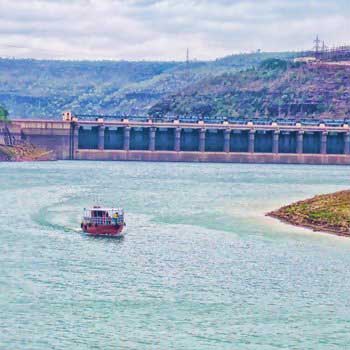Explore the Rich Heritage of Srisailam: Temples, Dams, and Wildlife

Srisailam, renowned for the Lord Mallikarjuna temple, is considered one of the oldest cities in India. Its wealth of epigraphical inscriptions suggests it existed around 40,000 years ago. The earliest reference to Srisailam, identifiable as "Hill-Srisailam," can be found in Pulumavi's Nasik inscription from the 2nd century AD. Srisailam has played a pivotal role in the religious, cultural, and social history of India since ancient times. This historical and sacred city boasts numerous destinations and attractions. Key sites in Srisailam include:
Srisailam Temple:
Perched on the flat summit of the Nallamalai Hills, this temple, dedicated to Mallikarjuna—a form of Lord Shiva—is among the most revered Hindu temples in India and one of the 275 Paadal Petra Sthalams. Located on the right bank of the River Krishna in the Kurnool district of Andhra Pradesh, the temple is particularly auspicious for visits on holy days, attracting numerous devotees with its promise of good fortune and enlightenment. The temple's surrounding landscape is also stunning, drawing many tourists.
Srisailam Dam:
This imposing structure spans the Krishna River, overlooking the lush Nallamala Forest. Built to harness the powerful current of the river, the dam is set in a deep canyon, rimmed by scenic forests—a perfect spot for witnessing the awe-inspiring force of nature from the designated viewpoint.
Patalganga River:
Flowing downstream, the River Krishna exudes a spiritual aura, enhanced by the scenic beauty around it. Visitors can enjoy a dip in the river, reputed to treat skin ailments, or take a scenic ropeway ride over the river. According to mythology, during the Mahabharata era, Arjuna created this tributary of the River Ganges by shooting an arrow into the ground to quench Bhishma's thirst.
Paladhara and Panchadhara:
These natural springs, located in a dense forest, are historically significant as the meditation spots of Sri Adi Shankaracharya. Steps lead down to serene settings where effigies of Sri Shankaracharya and Goddess Sarda dei have been installed as a tribute. This site, steeped in tranquility, also bears testament to the hymns Sri Shankaracharya composed in honor of Lord Mallikarjuna.
Srisailam Tiger Reserve Overview:
Covering 3,568 acres, this reserve is one of India's largest and includes notable features like the Srisailam and Nagarjunasagar Dams. The reserve is home to a diverse array of wildlife, including tigers, leopards, sloth bears, dholes, and various species of deer and reptiles. Crocodile breeding programs supported by the local government also operate here.
How to Reach Srisailam:
The nearest airport is in Hyderabad, approximately 195 km away, with frequent bus connections available. For those traveling by road, regular bus services connect Srisailam with major cities including Nellore and Vishakhapatnam. While there is no direct train service to Srisailam, the nearest station is in Cumbum district, 60 km away.
FAQs:
What is the significance of Srisailam Temple?
The Srisailam Temple, dedicated to Lord Mallikarjuna, stands atop the Nallamalai Hills in Andhra Pradesh. It is revered as one of the oldest and most sacred Hindu temples in India, attracting devotees seeking blessings and spiritual enlightenment. The temple is part of the 275 Paadal Petra Sthalams and boasts a breathtaking landscape that enhances its spiritual allure.
What are the main attractions at Srisailam Dam?
Srisailam Dam, situated on the Krishna River amidst the scenic Nallamala Forest, is a marvel of engineering and natural beauty. Visitors can witness the powerful river currents from designated viewpoints, offering stunning vistas of the surrounding forested canyon. The dam is a popular spot for nature enthusiasts and photographers alike.
What wildlife can be found in Srisailam Tiger Reserve?
Srisailam Tiger Reserve, sprawling over 3,568 acres, is renowned for its biodiversity and conservation efforts. It is home to a diverse range of wildlife, including tigers, leopards, sloth bears, dholes, various deer species, and reptiles. The reserve also supports crocodile breeding programs, making it a significant hub for wildlife enthusiasts and conservationists.